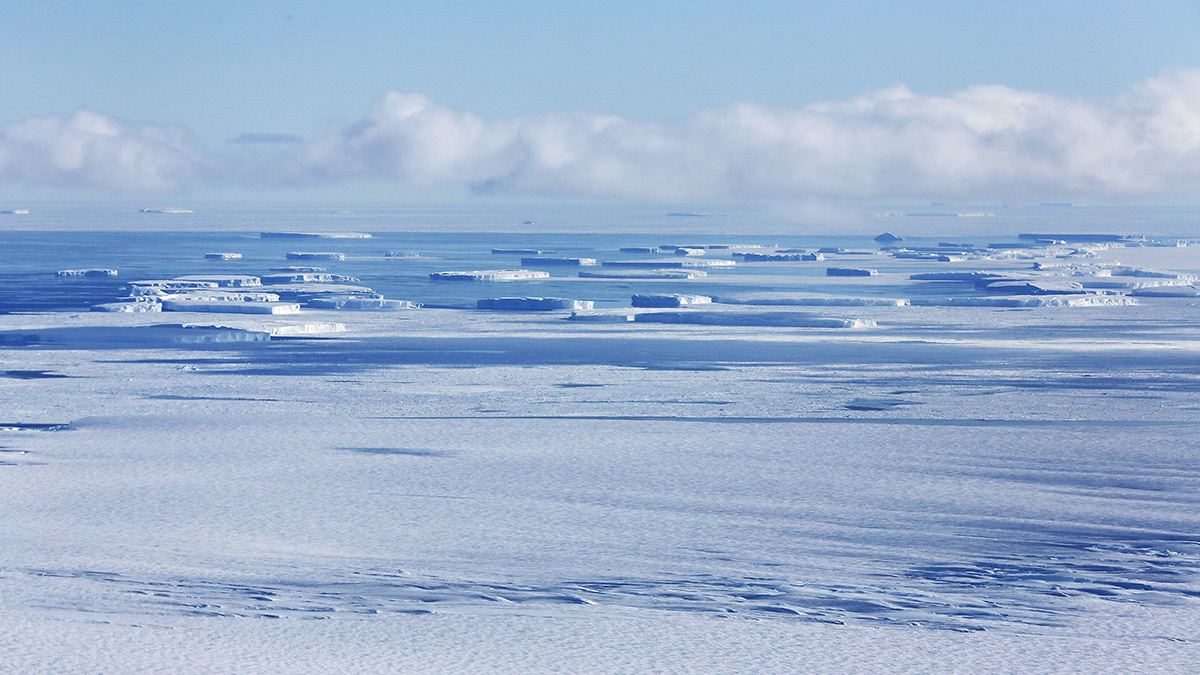

Tabular icebergs float near the coast of West Antarctica as seen from a window of a NASA Operation IceBridge airplane on Oct. 28, 2016. Mario Tama / Getty Images
For the first time, scientists have proven that the thinning ice shelves floating around Antarctica are driving ice loss from the interior of the continent as well, according to new research published in the journal Geophysical Research Letters.
The weakening of the ice shelf means that more ice is flowing from the interior of the continent into the ocean. The study finds that there is an immediate link between the ebbing thickness of the ice shelves and the acceleration in the glaciers feeding behind them, which spells trouble for sea level rise. The findings upend the notion that there is a delay between the ice shelves melting and the glaciers moving towards the sea, as the BBC reported.
In other words, the glaciers will speed up as the floating ice gets weaker, and then they will dump themselves into the ocean.
“The response is essentially instantaneous,” said Hilmar Gudmundsson who led the research team from Northumbria University in the UK, to the BBC. “If you thin the ice shelves today, the increase in flow of the ice upstream will increase today — not tomorrow, not in 10 or 100 years from now; it will happen immediately.”
The Antarctic Ice Sheet covers about 98 percent of the continent and is Earth’s largest single ice mass. As it loses size, it adds to sea level rise. It has always been held in place by the floating ice shelves encircling Antarctica. However, those ice shelves are starting to thin out either from warming waters or changes in ocean circulation, as Newsweek reported.
To examine the effect that the shelf has on the Antarctic Ice Sheet, Gudmundsson and his team of scientists pored over nearly 25 years of satellite data from the 1990s to 2017 and homed in on the point where the land-based ice sheet meets the floating ice shelf, a point known as the “grounding line.”
The team then used a state-of-the-art ice-flow model and measurements of changes in the geometry of ice shelves to calculate the changes in grounded ice flow. When the modeled results were compared with those obtained by satellites over the last 25 years, the researchers found what they described as ‘striking and robust’ similarities in the pattern of ice flowing from the ice sheet into the ocean, according to a statement from Northumbria University.
“I found it striking how well our modeled changes agree with the pattern of observed mass loss,” said Gudmundsson, as Newsweek reported. “There are other processes in play as well, but we can now state firmly that the observed changes in ice-shelves do cause significant changes over the grounded ice, speeding up its flow into the ocean.”
The biggest changes were spotted in Western Antarctica, which already makes a significant contribution to sea level rise. With one of the glaciers there, evidence of the changes in the floating shelf and the diminishing ice sheet could be seen 100 miles inland from the grounding line, according to a university statement.
“It is striking how far inland the changes in ice shelves can impact the ice sheet flow,” said Fernando Paolo, a postdoctoral scholar at the CalTech’s Jet Propulsion Laboratory, in a university press release. “Since we now know that shrinking ice shelves are directly responsible for increases in ice discharge to the ocean, it is important that we keep monitoring them to watch how they evolve.”
- Scientists Study Ice Shelf by Listening to Its Changing Sounds ...
- Antarctica's Ice Is Melting 5 Times Faster Than in the 90s - EcoWatch

 233k
233k  41k
41k  Subscribe
Subscribe 